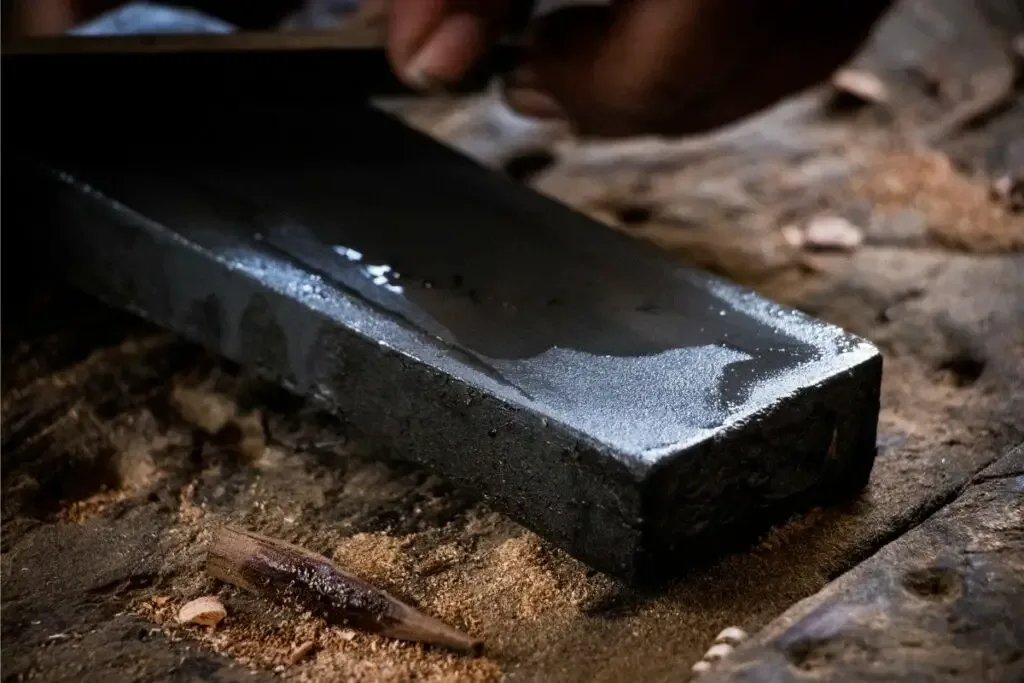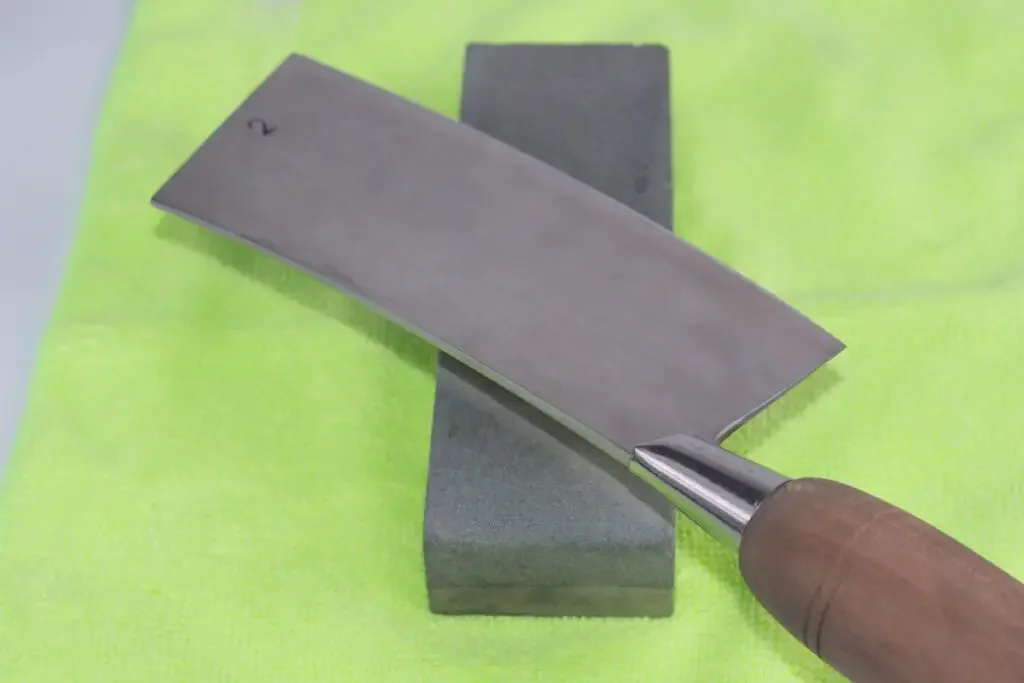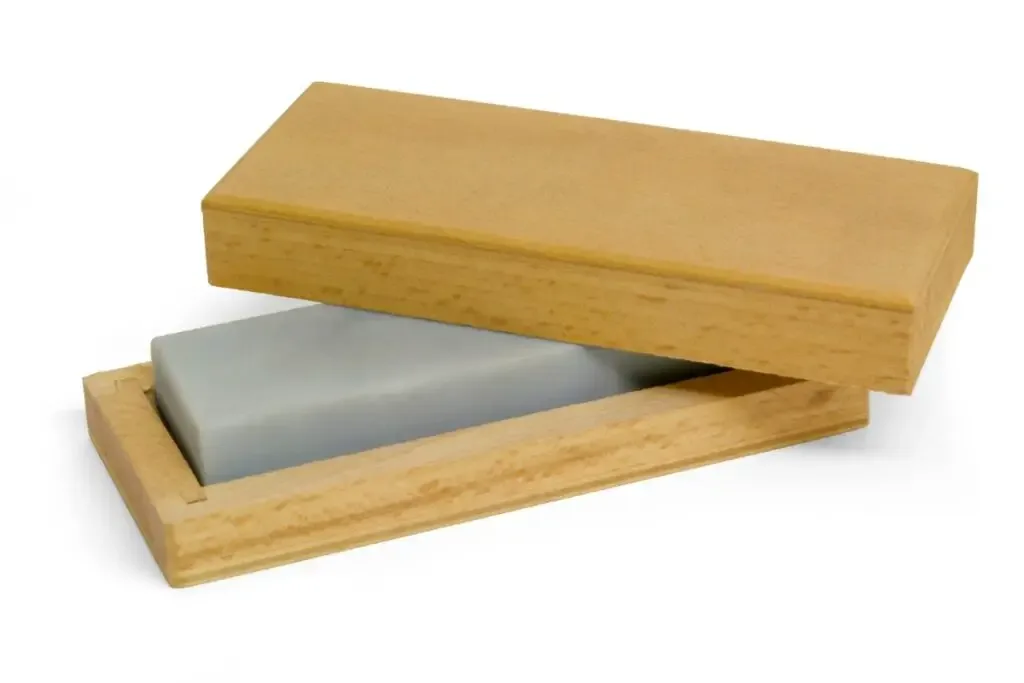As an Amazon Associate, we earn from qualifying purchases with no additional costs for you.
Sharpening stones have long been an essential tool for anyone looking to hone blades to perfection. Whether a chef seeking the perfect edge on a kitchen knife or a craftsman working on a woodworking tool, the choice of sharpening stone plays a high-profile role in achieving the required sharpness. When it comes to sharpening stones, two main types often spark debate: Natural Sharpening Stones and Synthetic Sharpening Stones.
Natural and synthetic stones have advantages and disadvantages, contributing to their suitability for various sharpening tasks. Cost, availability, and consistency in grain size favor synthetic stones, while durability and precision favor natural stones. Synthetic stones are more commonly used.
In this comprehensive guide, we will seek out the differences between natural and synthetic sharpening stones and grit ranges and evaluate their performance in various applications.
Whether you’re a professional looking to invest in the best sharpening tools or a hobbyist curious about the nuances of these stones, we can help you decide which sharpening stone will work best for your application.
If you are looking for a good quality whetstone set, we highly recommend the SHAPTON Ha No Kuromaku Ceramic Whetstone rough, medium, and fine grit set for general sharpening tasks. You can find this set here. (Amazon Link)
Should You Use Natural Or Synthetic Sharpening Stones?

As the name suggests, natural sharpening stones are derived from natural quarries and have unique characteristics that many enthusiasts admire. On the other hand, synthetic sharpening stones are engineered products designed to offer consistency and specific performance attributes.
Both types of sharpening stones have advantages and disadvantages, and the choice between the options can be a complex decision.
We need to understand a little about both stone types before making an informed decision as to which option will suit our sharpening requirements the best.
Understanding Natural Sharpening Stones

Natural Sharpening Stones have been used for centuries to sharpen tools and weapons. Their unique characteristics and appeal continue to attract those who value tradition and the intrinsic beauty of natural materials. In this section, we’ll explore what natural sharpening stones are, their advantages, and their disadvantages.
Natural sharpening stones are rocks or minerals naturally formed over millions of years. These stones are typically found in rivers, quarries, or mines and are mined or collected for the purpose of sharpening knives and other cutting tools.
Advantages Of Natural Sharpening Stones
One of the main advantages of natural sharpening stones is their ability to provide a high level of sharpening precision with higher grit stones, but this is often not the case with lower grit stones.
They are known for producing a refined edge on blades made of certain lower alloys, making them popular among professional craftsmen and enthusiasts who use these types of blades.
Natural stones also tend to have a wide range of grits available, allowing users to choose the appropriate level of coarseness for their specific sharpening needs. However, the grit of the stone is not consistent all the way through, which is unsuitable for certain blades requiring a finely honed edge.
Another advantage of natural sharpening stones is their ability to absorb and retain water or other lubricant. When soaked in water, these stones release a thin layer of water that acts as a lubricant during the sharpening process.
This helps prevent overheating the steel and damage to the blade’s edge, resulting in a smoother and more effective sharpening experience.
Natural stones can be particularly suitable for sharpening specific types of blades, especially low-alloy steels. These stones’ natural grit and texture may provide a more refined and controlled sharpening experience, allowing for a finely honed edge.
Additionally, natural sharpening stones are often highly regarded for their aesthetic appeal. They come in a variety of colors and patterns, with each stone displaying unique and beautiful characteristics. Many users appreciate the natural beauty of these stones and enjoy the sensory experience of using them.
TIP: Are you looking to buy a new whetstone? Check out our recommendations (we personally use the first three ones):
Our PRO choice whetstones combo (Amazon links):
- Fixing stone: Whetstone SHAPTON Ceramic KUROMAKU #320
- Sharpening stone: Suehiro CERAX soaking whetstone: Medium #1000
- Finishing stone: Whetstone SHAPTON Ceramic KUROMAKU #5000
Our budget choice (Amazon link): Sharp Pebble Extra Large Sharpening Stone Set
Disadvantages Of Natural Sharpening Stones
There are also some disadvantages to using natural sharpening stones. One of the main challenges is the need for regular maintenance.
Natural stones require flattening and leveling to ensure a consistent and even sharpening surface. This process can be time-consuming and may require the use of additional tools or accessories.
Natural sharpening stones can be relatively expensive compared to synthetic alternatives. These stones’ rarity and unique properties contribute to their higher price point. Additionally, natural stones may vary in quality, and finding high-quality ones can be challenging.
Natural sharpening stones, while highly regarded for producing a superior edge on blades, are often plagued by a frustrating inconsistency. The irregularity of these stones stems from their formation in nature, where various geological factors contribute to their composition.
The challenge of inconsistency in abrasive grain size leads to uneven sharpening and requires a skilled hand to navigate. While some users appreciate this uniqueness, others may find it frustrating and prefer the predictability of synthetic stones.
As a result, the density, hardness, and abrasive properties can vary significantly from one stone to another. This inconsistency poses a challenge for craftsmen and sharpening enthusiasts, as it requires careful selection and testing to find a stone that suits their specific needs.
Additionally, the varying characteristics of natural sharpening stones can make achieving a consistent edge a challenging and time-consuming process.
Despite these inconsistencies, many still appreciate the unique qualities and exceptional performance of natural sharpening stones, making them a prized tool for those dedicated to honing their blades to perfection.
TIP: Part of sharpening stone maintenance is ensuring the stone is flat for effective sharpening. Find out the best ways to flatten your sharpening stones in our article below!
4 Proven Ways: How To Flatten Sharpening Stone (Whetstone)
Understanding Synthetic Sharpening Stones

Synthetic sharpening stones have become increasingly popular due to their consistent performance and wide availability. Engineered to meet specific needs, these stones offer a range of advantages and some disadvantages compared to their natural counterparts.
What Are Synthetic Sharpening Stones?
Synthetic Sharpening Stones are manufactured using industrial processes, combining abrasive materials like Aluminum Oxide and Silicon Carbide with binding agents. Unlike natural stones, synthetic stones are designed to have consistent grit and hardness, making them more predictable in their performance.
Advantages Of Synthetic Sharpening Stones
Synthetic stones have become more commonplace than natural sharpening stones because of the advantages offered by the synthetic version.
- Consistency. One of the main advantages of synthetic stones is their consistency. The manufacturing process ensures uniform grit and hardness, leading to predictable sharpening results. This can be particularly beneficial for those who require precision in their sharpening tasks.
- Engineered for Specific Alloys. Synthetic stones can be engineered to cut and polish specific modern alloys. This allows for a tailored sharpening experience, making them suitable for a wide range of blades, including wear-resistant steels.
- Affordability. Generally, synthetic stones are more affordable than natural stones. Their mass production and standardized manufacturing processes lead to lower costs, making them accessible to a broader audience.
- Availability. Synthetic stones are widely available and come in various grit ranges and compositions. This makes it easier for users to find the exact stone that fits their needs and preferences.
TIP: Shapton is a top-quality sharpening stone, but how does it compare to a glass stone? Find out in our article where these stones are compared!
Shapton Kuromaku Vs. Glass Stone: What Works Best?
Disadvantages Of Synthetic Sharpening Stones
Even though synthetic stones have many advantages that make them popular among people who sharpen their own knives, they have some disadvantages that may make them unsuitable in certain situations.
- Potential limitations for very fine grits. Although synthetic stones are available in various grits, achieving very fine grits with a hard bond can be challenging. Some natural stones may offer superior performance in this regard.
- Durability concerns. Certain synthetic stones may wear down more quickly than natural ones, especially when used on hard materials. Understanding the composition and proper care of synthetic stones can mitigate this issue.
- Environmental considerations. The manufacturing process of synthetic stones often has negative environmental impacts, such as energy consumption and waste production. Those concerned with sustainability may prefer natural stones.
- Lack of natural appeal. While synthetic stones offer many practical advantages, they may lack natural stones’ aesthetic appeal and sensory experience. Some users may miss the unique patterns, colors, and earthy smell associated with natural stones.
Synthetic Sharpening Stones offer a modern solution to sharpening needs, with advantages like consistency, affordability, and tailored performance. However, they also come with certain disadvantages, such as a lack of natural appeal and potential durability concerns.
PRO TIP: We personally use diamond plates by Atoma. They are quite expensive but of the top quality with very long service life.
The initial costs are higher but you have an option of buying replacing diamond skin for all Atoma plates. The costs of replacing diamond skin are much lower than the cost of buying a new diamond plate.
So if you are going to use diamond plates regularly and want to get the best quality on the market, check out the four Atoma diamond plates listed below (Amazon links).
- Atoma Diamond Sharpener Coarse Grade 140 Grit
- Atoma Diamond Sharpener Medium 400 Grit
- Atoma Diamond Sharpener Fine 600 Grit
- Atoma Diamond Sharpener Super Fine 1200 Grit
These 4 diamond sharpening stones are all you need to have for repairing or sharpening your knives.
Comparing Natural And Synthetic Sharpening Stones
The choice between natural and synthetic sharpening stones is not merely a matter of personal preference; it involves understanding each type’s distinct characteristics, advantages, and disadvantages.
In the table below, we will compare natural and synthetic sharpening stones across various aspects to comprehensively understand their differences.
| Aspect | Natural Sharpening Stones | Synthetic Sharpening Stones | Conclusion |
| Hardness and Grit Range | Vary in hardness and grit; prized for fine grits. | Engineered for consistency; suitable for modern alloy steels. | While natural stones offer a unique and traditional experience, synthetic stones provide predictability and are tailored for specific materials. |
| Performance and Efficiency | Known for its aesthetic appeal, unique patterns, and earthy smell. | More efficient and consistent; suitable for professional applications. | Natural stones may appeal to enthusiasts and artisans, while synthetic stones are often preferred for professional and precise applications. |
| Aesthetic Appeal and Sensory Experience | Lack natural appeal but offers practical advantages. | More affordable and widely available; caters to various needs and budgets. | The choice here may depend on personal preferences and the value placed on aesthetics versus practicality. |
| Cost and Availability | Often more expensive and harder to find; focus on craftsmanship and tradition. | Manufacturing may involve energy consumption and waste; and environmental considerations. | Synthetic stones may be more accessible to the general public, while natural stones may be sought after by enthusiasts and collectors. |
| Environmental Considerations | Quarried from natural sources; potential sustainability concerns. | Manufacturing may involve energy consumption and waste; environmental considerations. | Both types have environmental considerations, and the choice may depend on individual values and concerns related to sustainability. |
The table captures the complex landscape of considerations when comparing natural and synthetic sharpening stones. From performance and efficiency to aesthetics and environmental impact, the choice between these two types of stones is multifaceted.
Whether embracing the tradition and craftsmanship of natural stones or the consistency and practicality of synthetic ones, the decision is a personal journey that reflects the individual’s connection to the tools and the sharpening process itself.
TIP: Most sharpening stones need a lubricant of some sort to increase the stones’ sharpening effectiveness and preserve the stone for longer. Our article below has everything you need to know about lubricating sharpening stones!
Lubricating A Sharpening Stone: The 12 Do’s & Don’ts
How To Choose The Right Sharpening Stone

Choosing the right sharpening stone is a decision that goes beyond simply picking between natural and synthetic. It involves understanding your specific needs, preferences, and the tools you’ll be sharpening.
Determine The Material And Grit
Consider the material of the stone, such as Novaculite for natural stones or Aluminum Oxide (Amazon links) for synthetic stones. Each material offers different characteristics.
Determine the grit range needed for your sharpening tasks. Coarser grits are used for shaping, while finer grits are used for polishing.
Consider the Purpose and Type of Blade
Are you sharpening kitchen knives, woodworking tools, or something else? The purpose will influence the choice of stone. Different blades, such as wear-resistant steels or low-alloy steels, may require specific stones.
Evaluate Your Budget and Preferences
Natural stones may be more expensive, while synthetic stones offer affordability. Consider your budget when making a choice.
Do you value natural stones’ aesthetic appeal and tradition, or do you prefer the consistency and efficiency of synthetic stones?
Think About Maintenance And Care
Natural stones may require more maintenance, while synthetic stones might be easier to care for. Consider your willingness to invest time in maintenance. Proper care extends the life of the stone. Understand the care requirements of the stone you choose.
Explore Specific Options
We can recommend several specific sharpening stones in the synthetic and natural categories (Amazon links).
- Japanese Naturals. Known for quality and fine grits, suitable for specific sharpening tasks.
- Arkansas Oil Stone. A popular natural stone option with different hardness levels.
- Silicon Carbide Synthetic Stones. A common synthetic option with various grit ranges.
Choosing the right sharpening stone is a thoughtful process that requires consideration of various factors, from material and grit to purpose, budget, and personal preferences.
Whether you’re drawn to the tradition and beauty of natural stones or the practicality and affordability of synthetic ones, understanding these aspects will guide you to the perfect stone for your needs.
Conclusion
The variety of sharpening stones is rich and diverse, offering a vast array of options for those seeking to hone their blades to perfection.
From the earthy charm and tradition of natural sharpening stones to the engineered precision and consistency of synthetic ones, the choice is a complex and personal one.
Whether you’re a professional chef, a woodworking artisan, a collector, or simply someone who appreciates the art of sharpening, the right stone is more than just a tool.
It’s about finding the perfect balance between tradition and innovation, aesthetics and practicality, investment and return.
The perfect sharpening stone resonates with your needs, enhances your skills, and adds joy to the sharpening experience.
TIP: Knife sharpeners are consumable items that wear out and need replacing from time to time. Find out all the ins and outs of how sharpening stones wear out in our article on the topic.
Do Knife Sharpeners Wear Out? Answer for Various Sharpeners
